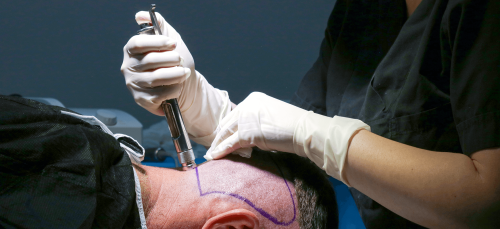What is painless hair transplantation
Painless hair transplantation refers to modern hair transplantation techniques that offer a more comfortable experience compared to traditional hair transplantation methods, where patients experience minimal pain and discomfort. Today, there are various methods used for painless hair transplantation:
Local Anesthesia: Hair transplant operations are usually performed under local anesthesia. Local anesthesia numbs only a specific area and does not require general anesthesia of the patient. This ensures that pain is minimized during the operation.
Use of Advanced Technology: Modern devices and technologies used for painless hair transplantation enable a more precise approach during the surgical procedure. For example, micromotors or manual devices allow for more controlled and comfortable removal of individual hair follicles.
DHI (Direct Hair Implantation): DHI is a technique that removes hair follicles at once using a special pen and transfers them directly to the transplantation site. This method allows for a more precise and controlled placement of hair follicles in the transplantation area during the operation.
Minimally Invasive Approach: Painless hair transplantation techniques usually adopt a minimally invasive approach. This can speed up the post-operative recovery process and minimize pain.
Painless hair transplantation can allow patients to feel less discomfort during the operation, making the hair transplant experience more positive. However, depending on the individual’s specific circumstances and preferences, the method that works best for everyone may differ. Therefore, it is important to have a detailed discussion with a hair transplant specialist.

Who can have painless hair transplantation
Painless hair transplantation is generally suitable for many people who have hair loss problems and want to solve this situation. However, individuals with the following conditions may be more interested in painless hair transplantation:
People with Low Sensitivity and Pain Threshold: Individuals who have a low pain threshold or sensitivity to pain may have a more comfortable experience with painless hair transplantation techniques.
Those with Sensitivity to Traditional Surgery: Traditional hair transplantation methods may cause some people to be wary of surgical procedures. Painless hair transplantation can reduce this sensitivity by using local anesthesia and less invasive techniques.
Those seeking aesthetic and natural results: Painless hair transplantation is an ideal option for individuals who aim to achieve natural results with modern technology and techniques. The advanced technology used to provide a soft beard line and natural distribution appeals to people with aesthetic concerns.
Those Who Want Fast Recovery: Painless hair transplantation is known for its minimal tissue damage and fast recovery advantages. This feature allows individuals to return to normal in a shorter time after the operation.
Those Looking for a Short Procedure: While traditional hair transplant operations can often take a long time, painless hair transplant techniques can offer a faster procedure.
Since everyone’s individual needs are different, it is important to have a detailed consultation with a hair transplant specialist to determine the most suitable candidate for painless hair transplantation.
What is the process after painless hair transplantation?

The painless post-hair transplant process is supported by modern techniques that focus on ensuring patients have a comfortable recovery. This process usually consists of the following stages:
Immediate Post-Period: Immediately after the painless hair transplant operation, patients usually enter a period of rest and recovery. Thanks to local anesthesia, minimal pain is felt during the operation, making for a comfortable experience immediately afterwards.
First Few Days: In the first few days after the operation, mild swelling and redness may be experienced. However, since painless hair transplantation usually adopts a minimally invasive approach, these symptoms usually subside quickly.
Hair Washing and Care: It is important to pay attention to the hair washing process in the first days. Hair washing instructions should be followed as recommended by the doctor. Special shampoos and care products can be used.
Crusting Period: After hair transplantation, the hair follicles are first shed and then the crusting period begins. During this period, crusts may form in the transplanted area. This process is part of the healing and new hair growth process.
Controls After the First Week: A follow-up appointment is usually made within the first week after the operation. The doctor evaluates the healing process and makes recommendations if necessary.
First Month: During the first month, mild swelling and redness can often persist in the transplanted areas. However, these symptoms decrease over time and the healing process continues.
After Three Months: Within three months after hair transplantation, new hair growth usually begins. However, it may take several months to achieve full results.
The process after painless hair transplantation may vary depending on the individual’s specific healing speed. Therefore, it is important to act in accordance with the instructions and recommendations given by the doctor.




